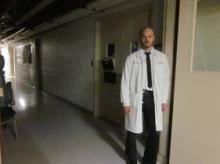Ghosts and the specter of medicine
"We all have ghosts," said my critical care attending one early morning in the ICU.
We were discussing a particularly prickly surgery attending who often admitted patients to the ICU after his 12-hour cases. He would make the house-staff do paperwork while he wrote all of his own orders, chastising any resident who so much as gave fluids to "his" patient without permission. This particular surgeon, "Dr. Jones," specialized in pancreatic cancer and the Whipple procedure, which, as most physicians know, is an exceedingly long, invasive, and dangerous surgery that serves as a last-ditch effort to remove cancer from the pancreas and extend a patient’s life. Whipple surgeons are generally known for their courage to operate on sick patients who have dismal survival rates with or without surgery, their hardened exterior – and for their ability to verbally crush a medical student or resident with the same dexterity with which they wield their surgical instruments.
My attending went on, "By the time you have practiced for as long as Dr. Jones, on patients as sick as his, you can be sure he carries enough ghosts to weigh him down at night; which may give insight into his ‘abrasive’ personality," he paused. ... "Lord knows, I have my own set of ghosts...."
He then spoke of a patient that had died just days earlier. Nineteen years old, he was a previously healthy, all-American type of kid who had been electrocuted and had come to the ICU intubated but stable, until he suddenly went into cardiac arrest while his family looked on, screaming. I had witnessed it from across the unit while I was putting in a central line on another patient.
I had treated numerous sick and dying patients in my month with this particular attending, but that was the only day that I saw panic in his seasoned eyes, it was the only day I saw him have hurried movements, it was the only time I saw him not be able to control a death, that is, bring someone back from its brink or let someone be released to it, in an accepting, controlled, and even peaceful way. He looked off pensively, eyes glazed over, and I could tell he was staring at his collection of ghosts.
All internists, but especially hospitalists and intensivists have had countless patients die. Most deaths are expected and are accepted as part of the job, not leaving a mark on our soul. But ghosts are those patients who die or have bad outcomes, and they never quite leave us.
Their constant companionship in the depths of our consciousness is usually the result of one of many situations. It may be the way in which the patient died; unexpectedly, violently, inadvertently. Often, it is the role we played in the death; overlooking a piece of data, missing a sign or symptom, having a lapse of judgment, falling victim to one of the many heuristics – availability, anchoring, familiarity – that loom in the humanness that is a physician.
And then there is the worst of all: making a decision, ordering a test, or giving a patient a treatment, that ultimately causes her death. These are the patients who haunt us for weeks and months after the event as we replay the moments in our minds, wishing we could rewind the clock, looking desperately for the moment we made the real or perceived mistake, and feeling crushed by the guilt of an outcome we cannot change. They stay with us for decades, stinging anew whenever our minds bump into their memory.
Now, in my last month of residency, as I reflect back on my 4 years of internal medicine and pediatrics training, I realize I have already collected a handful of ghosts: the teenage boy with leukemia and neutropenia who presented with back pain. Because the pain was presumed to be from his steroids, it took me 6 hours to realize he had typhlitis and send him to the ICU. He didn’t die that night, though cancer took him eventually, and some even congratulated me for diagnosing him at all. But I hiked for hours the next day, in the snow, post call, sleep deprived, as I replayed the night over and over in my head, chastising myself for my carelessness, for my anchoring.
And then there was the full-term baby whose delivery I attended because the mom had become febrile. The baby was handed to me limp, pale, not breathing. For 30 minutes, we did chest compressions and tried to bring him back to life, but to no avail. We tried to console the screaming mom who had carried the babe for 9 months and the vomiting father whose dreams had been crushed, but our words were only air. The Root Cause Analysis showed that no physician was at fault. The patient was the victim of an uncommon but known risk of vacuum suctioning that the parents had agreed to. He had bled half of his blood volume into an area between the scalp and brain. For weeks, I didn’t sleep and barely functioned, and for a lifetime he will be with me, until the day my mind fades.







